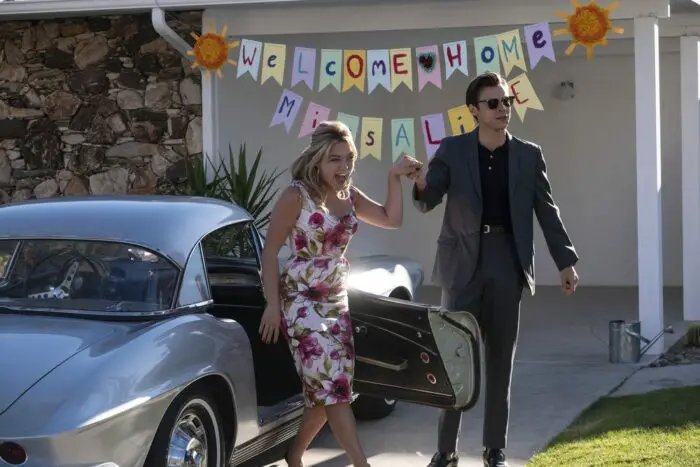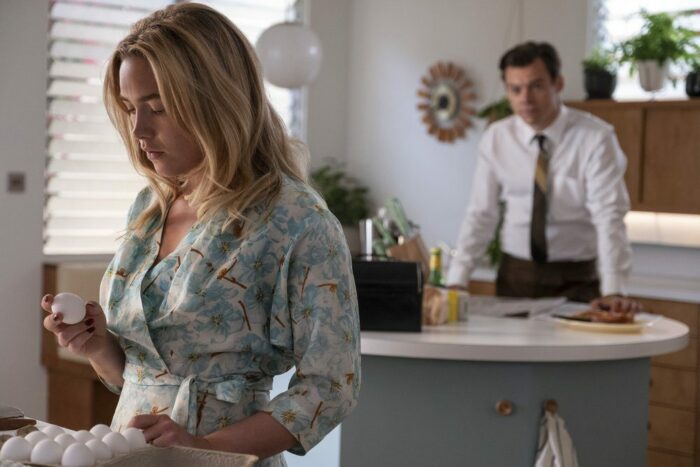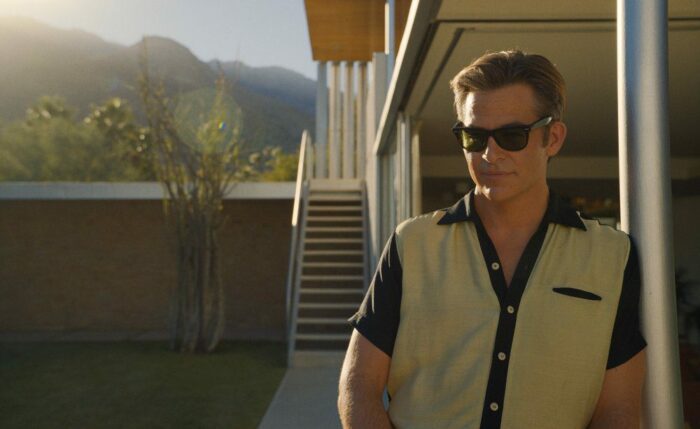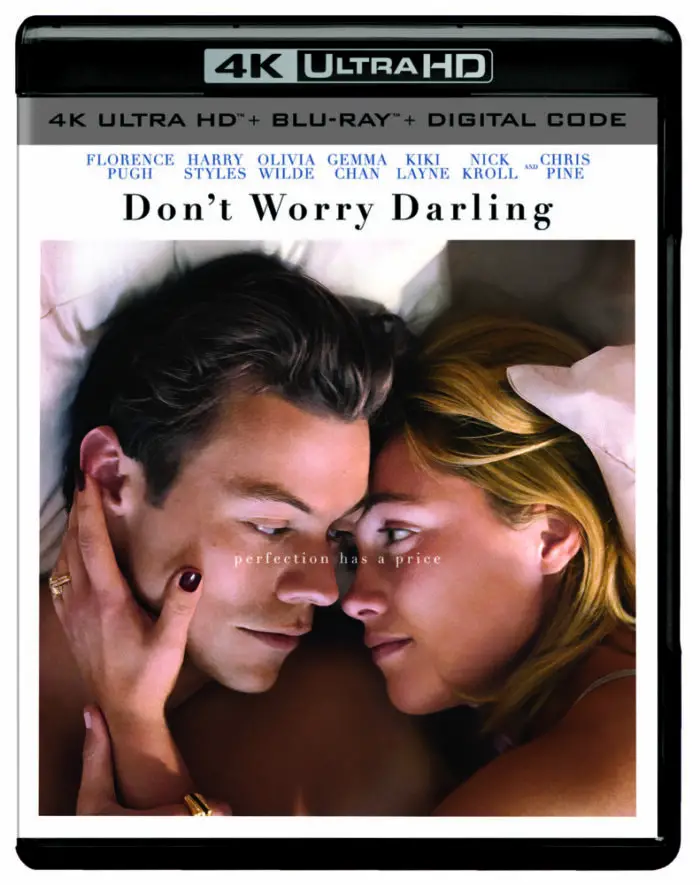Thanks to controversies surrounding spit and sizzle, the polarizing Don’t Worry Darling became quite the subject of many Twitterverse watercooler gossip conversations this past fall. After debuting on digital platforms last month, Olivia Wilde’s twisty pot-boiler arrives to 4K-UHD and Blu-ray physical media on November 29, 2022. Our own staff writer Aqib Rasheed reviewed the problematic film for 25YL Media when it hit theaters. Here’s assistant editor Don Shanahan with an opposing second opinion and an “Off the Shelf” review of its disc presentation.
THE MOVIE

Here in Olivia Wilde’s mindbender, a swanky soundtrack of 1950s toe-tappers including selections from the Great American Songbook gives the film a sunny haze that becomes varnish over a nightmare. Played for its lovely romantic style, a song like “Where or When” by Peggy Lee and the Benny Goodman Sextet has lyrics that creep into your psyche if you listen closely.
That varnish swirls with the dreamy déjà vu vibes that, thematically, tell you all you need to know about the encroaching mystery. By the time Don’t Worry Darling calls back to “Where or When” again during its kaleidoscopic end credits, a smoky aftermath is exhaled from the intoxicating effects of the song and the film.

Little Women Oscar nominee Florence Pugh and One Direction Grammy winner Harry Styles are Alice and Jack. Their young couple is soaked in booze and flush with young love. They are one frivolous married pair of many that occupy a mid-century southern California cul-de-sac where the men go to work as synchronized commuters and the women embrace their homemaker zest pining for their returns and downing more cocktails. The slices of charmed lives these neighbors enjoy is afforded to them by the Victory Project, an isolated community organized by Chris Pine’s enigmatic Frank.
Spoken of with strict and unified devotion and living among them with his ballet instructor wife Shelley (Gemma Chan of The Eternals), Frank has recruited these handpicked men for undisclosed and ambiguous roles at the guarded worksite nestled in the surrounding desert hills. Stumping for his own cause any chance he gets, including his vocal commentary on the local radio channels, Franks preaches his aim for a “different and better way of life” that will “change the world.” He seeks people of “pure, unbridled potential” and warns how “chaos is the enemy of progress.” Meanwhile, the heads of the households work on the “development of progressive materials” and “seek a gem of immense value.” Heaven forbid they question the boss.

Just don’t mind the occasional ground tremor in town and ignore the frantically-frozen housewife Margaret (If Beale Street Could Talk’s KiKi Layne) who’s denying her meds. The vague importance pontificated by Frank and the whispers of portended doom from Margaret begin a myriad of question marks for the curious Alice. As she probes the limits and boundaries of their collective after witnessing what she thinks is a plane crash, Alice finds more secrecy and unwanted attention.
Chris Pine owns his scenes with nefarious and charismatic snake oil that softens what would normally be blunter with either gross evil or panache that you cannot take seriously. His gaze lands somewhere in the middle to flatter the women and coaxes nodding loyalties out of the men. For his Frank, it’s all about containment because he knows he can.
Next thing you know, she’s the next target for the label of madness and nonconformity in Don’t Worry Darling. The dangerous predicament for Alice is made worse when Jack stops believing her for fear of losing their lavish lifestyle. Their emotions are split and will likely never be healed without drastic events to follow.

Director Olivia Wilde, no stranger to captivating screen presence herself as an actress, provides Florence Pugh every opportunity to shine through this sun-baked wringer. Harry Styles cannot keep up, but it matters little with this being Pugh’s showcase. She is more than strong enough to get behind. Still, the slow boil to Chris Pine’s puppeteering above would have been helped by more intimate strife from the loving man across from the lead.
Wilde’s past Booksmart and future Spider-Woman screenwriter Katie Silberman penned a twisting thriller with, admittedly, less confusion than a Jordan Peele film by comparison. A few large scripted surprises are easy to sniff out. Others, however, get impressively daring. Still, dabbling in this kind of heady territory will pose problems with the fickle levels of audience disbelief that demand more stamped out answers than dangling questions when it’s all said and done.
With that in mind, soften the scalpels of credulity with Don’t Worry Darling. You’re not going to get told everything, and, honestly, you shouldn’t be. Know that you are entering pure manipulation territory. The bold presentation is a worthy entry into the pantheon of rug pulls and movies with repeat viewing potential, even if it’s to measure missteps versus successes.
THE DISC

Not unlike the movie itself, the physical media disc for Don’t Worry Darling raises a few questions. However, they’re not good ones. Is this it? Is there nothing else? Are none of the special features on the main 4K disc? Those are three inquiries that do not attract buyers. Unfortunately, what you see with your magnifying glass is all you get.
Don’t Worry Darling has only two, yes only two, special features. The first is “The Making of Don’t Worry Darling.” It’s your typical, by today’s standards, studio-commissioned BTS featurette that runs less than 20 minutes.
To its credit, the conversation of “The Making of Don’t Worry Darling” is led by director Olivia Wilde and her enthusiasm is high. She’s not the kind of talent stuck checking this featurette box from the work contract. This movie was her baby and one she was itching to make with an infectious urge for creating a psychological thriller from an original concept with a female heroine of complexity. She and screenwriter Katie Silberman kickstarted the collection of ideas that spilled across utopian studies, simulation theory, mental health, and challenging patriarchy .
Moreover, Olivia Wilde appears genuinely happy to put over her cast and crew from this production, despite the swirled rumors of production conflicts between actors and the director. Production designer Kate Byron and costume designer Arianne Phillips both were granted mini-spotlights to show off the origins and methods of those two artistic pillars of Don’t Worry Darling. Cinematographer Matthew Libatique was quick to shower the kudos right back to Wilde for assembling all the talent together.
For under 20 minutes, this feature did a very admirable job at examining the film’s in and outs. The detail was very decent despite its short-ish length. The same cannot be said for the only other special feature.
The Don’t Worry Darling disc carries a single deleted scene entitled “Alice’s Nightmare.” It’s a mere 30 seconds, shot in black-and-white, and has no dialogue. It depicts Alice crowd-surfing essentially above a bevy of black-costumed mystery figures who eventually want to chew her up. It’s stylish, but terribly brief. Surely, there couldn’t have been the only cut scene produced enough for a disc release.
Alas, that’s it for Don’t Worry Darling at home. An isolated soundtrack option or, of course, a director’s commentary from a game Olivia Wilde paired with Silberman would have set this disc off. Even worse, the two special features are stranded on the Blu-ray disc and not on the main 4K one. Between that demotion and WB’s usual uninspired bottom-bar menu design, the studio’s trend of overly-basic physical discs continues, and it’s always a shame.



